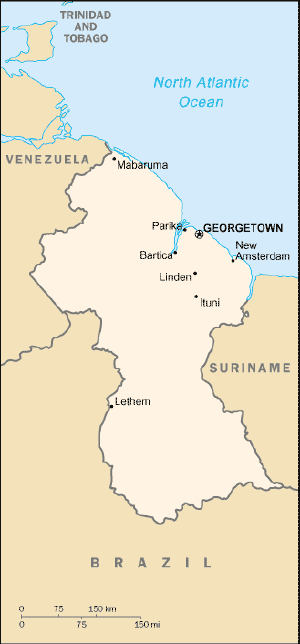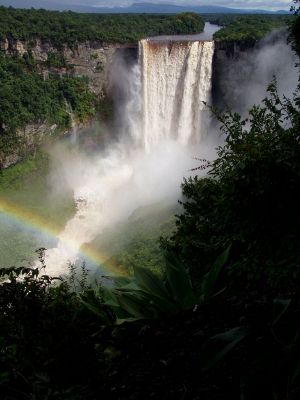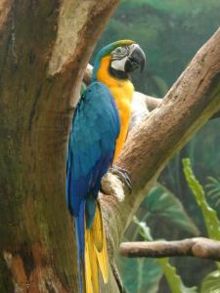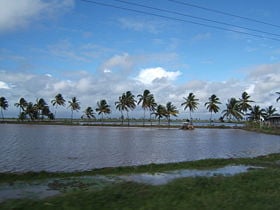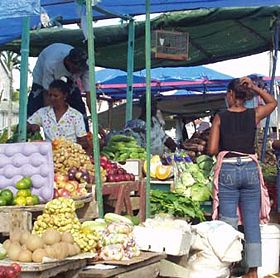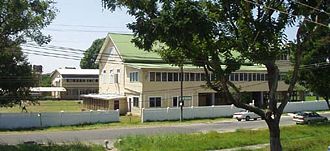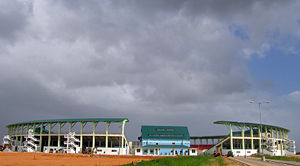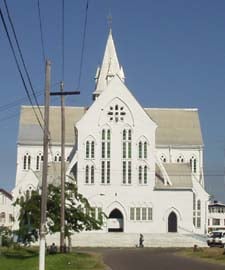Difference between revisions of "Guyana" - New World Encyclopedia
Vicki Phelps (talk | contribs) |
Vicki Phelps (talk | contribs) |
||
| Line 88: | Line 88: | ||
Venezuelan maps after 1962 started to show the territory as disputed or labeled it ''Zona en Reclamación'' (the "zone to be reclaimed"). After 1982, Venezuelan maps started to show Guayana Esequiba as an integral part of Venezuela without any indication that it was under Guyanese administration and in dispute. | Venezuelan maps after 1962 started to show the territory as disputed or labeled it ''Zona en Reclamación'' (the "zone to be reclaimed"). After 1982, Venezuelan maps started to show Guayana Esequiba as an integral part of Venezuela without any indication that it was under Guyanese administration and in dispute. | ||
| − | On November 15, 2007, a contingent of Venezuelan armed forces entered Guyana’s territory and destroyed two | + | On November 15, 2007, a contingent of Venezuelan armed forces entered Guyana’s territory and destroyed two two dredgers at a gold mine. That was followed by unauthorized overflights by two Venezuelan helicopters. Guyana protested the Venezuelan action and is seeking a diplomatic resolution of the issue. Caracas said the action was against illegal gold miners and was part of a program to strengthen security on Venezuelan borders. |
| − | the Venezuelan action and is seeking a diplomatic resolution of the issue. | ||
=== Environment and biodiversity === | === Environment and biodiversity === | ||
| Line 249: | Line 248: | ||
; General | ; General | ||
| − | |||
| − | |||
| − | |||
*[http://www.guymine.com Guymine.com] - Popular Guyanese website that focuses on Linden, the second largest town | *[http://www.guymine.com Guymine.com] - Popular Guyanese website that focuses on Linden, the second largest town | ||
*[http://www.sdnp.org.gy SDNP Guyana] - Guyanese directory and host to ministerial sites | *[http://www.sdnp.org.gy SDNP Guyana] - Guyanese directory and host to ministerial sites | ||
| Line 260: | Line 256: | ||
*[http://gfamass.tripod.com/symbols.html National Symbols of Guyana] | *[http://gfamass.tripod.com/symbols.html National Symbols of Guyana] | ||
*[http://news.bbc.co.uk/1/hi/world/americas/country_profiles/1211325.stm BBC profile of Guyana] | *[http://news.bbc.co.uk/1/hi/world/americas/country_profiles/1211325.stm BBC profile of Guyana] | ||
| − | |||
*[http://www.guyanaundersiege.com/Cultural/Hindus%20of%20South%20America.htm Hinduism in Guyana and Suriname] | *[http://www.guyanaundersiege.com/Cultural/Hindus%20of%20South%20America.htm Hinduism in Guyana and Suriname] | ||
*[http://jonoguyana.blogspot.com Guyana Resource Center] | *[http://jonoguyana.blogspot.com Guyana Resource Center] | ||
Revision as of 02:51, 1 December 2007
| Cooperative Republic of Guyana | ||||||
|---|---|---|---|---|---|---|
|
||||||
| Motto: "One people, one nation, one destiny" | ||||||
| Anthem: "Dear Land of Guyana, of Rivers and Plains" |
||||||
| Capital (and largest city) | Georgetown | |||||
| Official languages | English | |||||
| Demonym | Guyanese | |||||
| Government | Republic | |||||
| - | President | Bharrat Jagdeo | ||||
| - | Prime Minister | Sam Hinds | ||||
| Independence | ||||||
| - | from the United Kingdom | May 26 1966 | ||||
| - | Declared and Recognized | February 23 1972 | ||||
| Area | ||||||
| - | Total | 214,970 km² (84th) 83,000 sq mi |
||||
| - | Water (%) | 8.4 | ||||
| Population | ||||||
| - | July 2005 estimate | 751,0001 (162nd) | ||||
| - | 2002 census | 751,223 | ||||
| - | Density | 3.5/km² (217th) 9.1/sq mi |
||||
| GDP (PPP) | 2005 estimate | |||||
| - | Total | $3.489 billion (157th) | ||||
| - | Per capita | $4,612 (106th) | ||||
| Currency | Guyanese dollar (GYD) |
|||||
| Time zone | (UTC-4) | |||||
| Internet TLD | .gy | |||||
| Calling code | +592 | |||||
| 1 | Population includes excess mortality caused by AIDS. Around one-third of the population (230,000) live in the capital Georgetown. | |||||
Guyana, officially the Cooperative Republic of Guyana, is the only English-speaking country in South America. It is also one of four non-Spanish-speaking territories on the continent, along with the countries of Brazil (Portuguese) and Suriname (Dutch) and the French overseas region of French Guiana (French). Culturally it is more associated with the Caribbean than with Latin America.
Guyana is the third smallest country and the only nation state of the Commonwealth of Nations on the mainland of South America.
Guyana is an Amerindian word meaning "Land of many waters". The country is characterized by its vast rainforests dissected by numerous rivers, creeks, and waterfalls, notably Kaieteur Falls on the Potaro River. Guyana's highlands are famous for being the inspiration for Sir Arthur Conan Doyle's 1912 novel The Lost World. The country enjoys a diverse, multicultural society and high biodiversity of flora and fauna.
Geography
Guyana lies north of the equator, in the tropics, and is located on the Atlantic Ocean. It is bordered to the east by Suriname, to the south and southwest by Brazil and to the west by Venezuela. Guyana can be divided into four natural regions:
- a narrow and fertile marshy plain along the Atlantic coast, where most of the population lives and agriculture takes place,
- a white sand belt more inland that contains most of Guyana's mineral deposits (especially bauxite),
- a plateau covered with dense rainforests that stretches across the middle of the country,
- the grassy flat savanna in the south and the larger interior highlands, consisting mostly of mountains that gradually rise to the Brazilian border.
Guyana's main mountains are in the south, including Mount Ayanganna (6,699 ft; 2,042 m) and Mount Roraima (9,301 ft; 2,835 m) – the highest mountain in Guyana on the Brazil-Guyana-Venezuela border, part of the Pakaraima range in the west. Roraima is said to be have been the inspiration for The Lost World. There are also many steep escarpments and waterfalls, including the famous Kaieteur Falls. Between the Rupununi River and the border with Brazil lies the Rupununi savanna, an ancient lake bed, south of which lie the Kanuku Mountains.
There are many rivers in the country, the three main ones being (west to east) the Essequibo, the Demerara, and the Berbice. There is also the Corentyne along the border with Suriname. At the mouth of the Essequibo are several large islands. Guyana is a major breeding area for sea turtles (mainly leatherbacks) and other wildlife.
The local climate is tropical and generally hot and humid, though moderated by northeast trade winds along the coast. There are two rainy seasons, the first from May to mid-August, the second from mid-November to mid-January.
Boundary disputes
Guyana was in a border dispute with both Suriname, which claimed the land east of the Corentyne River in southeastern Guyana, and Venezuela, which claims the land west of the Essequibo River as part of Guayana Esequiba. The dispute with Suriname was arbitrated by the United Nations Convention on Law of the Sea, and a ruling in favor of Guyana was announced in September, 2007.[1], [2],[3]
When the British surveyed British Guiana in 1840, they included the entire Cuyuni River basin within the colony. Venezuela did not agree with this, as it claimed all lands west of the Essequibo River. In 1898, at Venezuela's request, an international arbitration tribunal was convened, which in 1899 issued an award giving about 94 percent percent of the disputed territory to British Guiana. Venezuela and Great Britain accepted the award by treaty in 1905.[1]
In 1962, Venezuela renewed its nineteenth-century claim, alleging that the arbitration award was invalid. The British and Guyanese rejected this renewed claim, and efforts by all the parties to resolve the matter on the eve of Guyana's independence in 1966 failed. On February 17, 1966, in Geneva, the parties agreed in principle to settle the dispute peacefully, but no other agreement was reached. Later in 1966, Venezuela occupied and annexed the Guyanese half of Ankoko Island in the Cuyuni River. On June 18, 1970, at the Port of Spain meetings of the Caribbean nations, Venezuela and Guyana signed a protocol placing a moratorium on discussions on the border issue for a period of twelve years. The moratorium expired and was not renewed.[1] The only current agreement recognized by both sides is a semi-official agreement between the Guyanese Defense Force and the Venezuelan army signed in 1990.
Venezuelan maps after 1962 started to show the territory as disputed or labeled it Zona en Reclamación (the "zone to be reclaimed"). After 1982, Venezuelan maps started to show Guayana Esequiba as an integral part of Venezuela without any indication that it was under Guyanese administration and in dispute.
On November 15, 2007, a contingent of Venezuelan armed forces entered Guyana’s territory and destroyed two two dredgers at a gold mine. That was followed by unauthorized overflights by two Venezuelan helicopters. Guyana protested the Venezuelan action and is seeking a diplomatic resolution of the issue. Caracas said the action was against illegal gold miners and was part of a program to strengthen security on Venezuelan borders.
Environment and biodiversity
Guyana abounds with plant and animal life. Each region boasts unique species. The following habitats have been categorized: coastal, marine, littoral, estuarine palustrine, mangrove, riverine, lacustrine, swamp, savanna, white sand forest, brown sand forest, montane, cloud forest, moist lowland and dry evergreen scrub forests. About 14 areas of biological interest have been identified as possible hotspots for a National Protected Area System.
More than 80 percent of Guyana is still covered by forests, ranging from dry evergreen and seasonal forests to montane and lowland evergreen rainforests. These forests are home to more than a thousand species of trees. Guyana's tropical climate, unique geology, and relatively pristine ecosystems support extensive areas of species-rich rainforests and natural habitats with high levels of endemism. Approximately eight thousand species of plants occur in Guyana, half of which are found nowhere else.
Guyana has one of the highest rates of biodiversity in the world. With 1,168 vertebrate species and 1,600 bird species, the country boasts one of the richest mammalian fauna assemblages of any comparably sized area in the world.
The Guiana Shield region is little known and extremely rich biologically. Unlike other areas of South America, over 70 percent of the natural habitat remains pristine.
The rich natural history of British Guiana was described by early explorers Sir Walter Raleigh and Charles Waterton and later by naturalists Sir David Attenborough and Gerald Durrell.
Ecology and World Heritage Site status
Guyana signed the Convention Concerning the Protection of the World Cultural and Natural Heritage in 1977. In the 1990s, Guyana began selecting sites for World Heritage nomination. The three sites considered were Kaieteur National Park, Shell Beach, and Historic Georgetown.
Guyana exhibits two of the World Wildlife Fund's Global 200 ecoregions most crucial to the conservation of global biodiversity and is home to several endemic species, including the tropical hardwood Greenheart (Chlorocardium rodiei).
History
When the first Europeans arrived in the area around 1500, Guyana was inhabited by the Arawak and Carib tribes of American Indians. Although Guyana was first sighted by Christopher Columbus during his third voyage (in 1498), it was not settled by Europeans until the Dutch in 1616, who established three separate colonies: Essequibo (1616), Berbice (1627), and Demerara (1752), and started sugar plantations. Soon the region was producing coffee, cotton, and cocoa as well.
Colonial status
The British assumed control in the late eighteenth century, and the Dutch formally ceded the area in 1814. In 1831 the three separate colonies became a single British colony known as British Guiana.
Escaped slaves formed their own settlements known as Maroon communities, but with the abolition of slavery in 1834 many of the former slaves began to settle in urban areas. Indentured laborers from modern-day Portugal (1834), Germany (first in 1835), Ireland (1836), Scotland (1837), Malta (1839), China, and India (beginning in 1838) were imported to work on the sugar plantations.
In 1889 Venezuela claimed the land up to the Essequibo. Ten years later an international tribunal ruled the land belonged to British Guiana.
In 1928 British Guiana was made a crown colony, a move that reasserted British control at a time when political and labor unrest was rising. Finally, in the 1950s the constitution was revised and general elections held. Dr. Cheddi Jagan and Forbes Burnham formed the People's Progressive Party (PPP), which won the elections. Jagan's radical reforms as prime minister concerned the British, who suspended the constitution until 1957. Burnham split from the PPP and formed the People's National Congress (PNC), supported primarily by Afro-Guianese.
The United States and United Kingdom feared that Jagan would create "another Cuba" in the Western Hemisphere if the colony were granted independence with Jagan in power and thus promoted political changes that favored the PNC.
Independence
Guyana achieved independence from the United Kingdom in 1966 and became a republic on February 23, 1970, though remaining a member of the Commonwealth. Burnham became the first prime minister and moved Guyana toward socialism, including nationalizing foreign companies that dominated the bauxite and sugar industries.
Guyana became aligned with the Soviet Union, and Burnham restricted press freedom and revised the constitution to stay in power. Upon his death in 1985, he was succeeded by Hugh Desmond Hoyte, who realigned Guyana with the United States and instituted economic reforms to encourage investment. In 1992, Jagan's PPP won the elections in free and fair elections but continued efforts to revive the economy. Amid political fighting after Jagan died in 1997, the PPP and PNC agreed on terms of a peace deal. Bharrat Jagdeo of the PPP became president and was elected president in 2001.
Politics
Politics of Guyana takes place in a framework of a semi-presidential representative democratic republic, whereby the president is the head of government, and of a pluriform multi-party system. Executive power is exercised by the government. Legislative power is vested in both the government and the National Assembly. The judiciary is independent of the executive and the legislature. The 2006 national elections were the first peaceful elections in recent memory; they were deemed free and fair.
Historically, politics is a source of tension in the country and violent riots have often broken out during elections. During the 1970s and 1980s, the political landscape was dominated by the People's National Congress (largely African). In 1992, former U.S. President Jimmy Carter oversaw the first "free and fair" elections and the People's Progressive Party (supported by East Indians) has led the country since. The two parties are principally organized along ethnic lines and as a result often clash on issues of governance.
Administrative divisions
Guyana is divided into 10 regions. The regions are divided into 27 neighborhood councils.
Economy
Chronic problems include a shortage of skilled labor and a deficient infrastructure. Until recently, the government was juggling a sizable external debt against the urgent need for expanded public investment. Low prices for key mining and agricultural commodities combined with troubles in the bauxite and sugar industries had threatened the government's tenuous fiscal position and dimmed prospects for the future. However, the Guyanese economy has rebounded slightly and exhibited moderate economic growth since 1999, based on an expansion in the agricultural and mining sectors, a more favorable atmosphere for business initiatives, a more realistic exchange rate, fairly low inflation, and the continued support of international organizations.
The main economic activities in Guyana are agriculture (producing rice and Demerara sugar), bauxite mining, gold mining, timber, shrimp fishing and minerals. The sugar industry, which accounts for 28% of all export earnings, is largely run by Guysuco, which employs more people than any other industry. Many industries have a large foreign investment. The mineral industry, for example, is heavily invested in by the American company Reynolds Metals, the Canadian Alcan and the Korean/Malaysian Barama Company has a large stake in the logging industry.
The production of balatá (natural latex) was once big business in Guyana. Most of the balata bleeding in Guyana took place in the foothills of the Kanuku Mountains in the Rupununi. Early exploitation also took place in the North West District, but most of the trees in the area were destroyed by illicit bleeding methods that involved cutting down the trees rather than making incisions in them.
Folk uses of balatá included the making of homegrown cricket balls, the temporarily filling of troublesome tooth cavities, and the crafting of figurines and other decorative items (particularly by the Macushi people of the Kanuku mountains).
Major private sector organizations include the Private Sector Commission (PSC)[2] and the Georgetown Chamber of Commerce & Industry (GCCI);[3] See a list of companies in Guyana.
In addition, the government initiated a major overhaul of the tax code with the start of 2007. The Value Added Tax (VAT) was brought into effect replacing six different taxes. Prior to the implementation of VAT it had been relatively easy to evade sales tax and many businesses were in violation of tax code. Many businesses were very opposed to VAT introduction because of the extra paperwork required, however the Government has remained firm on VAT. By replacing several taxes with one flat tax rate, it will also be easier for government auditors to spot embezzlement. While the adjustment to VAT has been a tough one, it may improve day to day life because of the significant additional funds the government will have available for public spending.
President Bharrat Jagdeo has made debt relief a foremost priority of his administration. He has been quite successful, getting US$800 million8 of debt written off by the IMF, the World Bank and the Inter-American Development Bank (IDB), in addition to millions more from other industrialized nations. Jagdeo was lauded by IDB President Moreno for his strong leadership and negotiating skills in pursuing debt relief for Guyana and several other regional countries.
Russia took control of a major part of the all-important Guyana bauxite industry in March 2006 when the Rusal company bought 90 percent of the Aroaima Mining Co. in Berbice. The Guyanese government retained the other 10 percent. Rusal later announced that it was also interested in buying into Guyana's other big bauxite producer, Omai.
Demographics
The population of Guyana (769,000) is racially and ethnically heterogeneous, composed chiefly of the descendants of immigrants who came to the country either as slaves or as indentured laborers. The population therefore comprises groups of persons with nationality backgrounds from Europe (United Kingdom and Portugal), Africa, China, and India, with the Amerindians as the indigenous population. The majority live in Georgetown, the capital; in two or three other towns, and along the coast. Large areas of mountains, savanna and rainforest are uninhabited.
Languages spoken are English, Amerindian dialects, Creole, Caribbean Hindustani (a dialect of Hindi), and Urdu.
The largest nationality sub-group is that of the East Indians, comprising 50 percent of the population in 2007. They are followed by persons of African heritage (36 percent). The third in rank are Amerindians with 7 percent; whites, Chinese, and mixed are 7 percent.
Culture
Guyana, along with Suriname, French Guiana, and Brazil, is one of the four non-Hispanic nations in South America. Guyana's culture is very similar to that of the English-speaking Caribbean, to the extent that Guyana is included and accepted as a Caribbean nation and is a founder member of the Caricom (Caribbean Community) economic bloc and also the home of the Bloc's Headquarters, the CARICOM Secretariat. Its geographical location, its sparsely populated rain forest regions, and its substantial Amerindian population differentiate it from English-speaking Caribbean countries. Its blend of East Indian (Asian Indian) and West Indian (black) cultures gives it similarities to Trinidad and distinguishes it from other parts of the Americas. Guyana shares similar interests with the islands in the West Indies, such as food, festive events, music, sports, etc. Guyana plays international cricket as a part of the West Indies cricket team, and the Guyana team plays first class cricket against other nations of the Caribbean. In addition to its CARICOM membership, Guyana is a member of CONCACAF, the international football federation for North and Central America and the Caribbean. Another aspect of Guyanese culture is its rich folklore about Jumbees.
Languages
English is the official language of Guyana. In addition, Amerindian languages (see Carib languages) are spoken by a small minority, while Guyanese Creole (an English-based creole with African and Indian syntax) is widely spoken. Grammar is not standardized. [4]
In addition to English, other languages of Guyana include Creole, Akawaio, Wai-Wai, Arawak and Macushi.
Religion
CIA: Religions: Christian 50%, Hindu 35%, Muslim 10%, other 5% The major religions in Guyana include Christianity (41.6 percent), Hinduism (28.8 percent), Islam (7.3 percent), Rastafarian (0.5 percent), and [Bahá'í]] (0.1 percent), with the remainder being of no faith or indigenous religions. Most Guyanese Christians are Protestants and include a mix of all races. Hinduism is dominated by the Indians who came to the country in the early 1800s, while Islam varies between Afro-Guyanese and Indian-Guyanese.
Education
Guyana's educational system, which at one time was considered among the best in the Caribbean, deteriorated in the 1980s because of the emigration of highly educated citizens and the lack of appropriate funding. Although it recovered somewhat in the 1990s, it still does not produce the quality of educated students necessary for Guyana to modernize its workforce.
The educational system does not, for example, focus on training in science and technology, technical and vocational subjects, business management, or computer sciences.
There are wide disparities among the geographical regions of the country in the availability of quality education, and the physical facilities are in poor condition. Furthermore, many of the better-educated professional teachers have emigrated to other countries over the past two decades, mainly because of low pay, lack of opportunities, and crime. As a result, there is a lack of trained teachers at every level of Guyana's educational system.
Cuisine
Guyanese cuisine has many similarities to that of the rest of the Caribbean. The food is diverse and includes dishes such as chicken curry, roti and cookup rice (a style of rice with different kinds of vegetables accompanied by chicken, beef or fish). The food reflects the ethnic makeup of the country and its colonial history, and includes dishes from the Africans and creoles, East Indians, Amerindians, Chinese, and Europeans (mostly British and Portuguese).
Staple dishes include chicken curry, roti, plain rice, cookup rice, breads, beef/chicken stews, and Caribbean-style chow mein. Caribbean and Latin American ground provisions are also part of the staple diet and include cassava, sweet potato, edoes and others. Unique dishes include Pepperpot, made with cassreep (an extract of the casava) and is of Amerindian origin. There is also Metemgie, a thick rich soup with a coconut base filled with ground provisions, and big fluffy dumplings and is traditionally eaten with fried fish, or, more recently, chicken. Most Guyanese love the Caribbean-style Chinese food sold in restaurants in the bigger towns. A favorite is Chicken in the ruff, which is fried rice with Chinese-style fried chicken on top.
There is an abundance of fresh fruits, vegetables and seafood on the coast. Most people use fresh fruit to make their own beverages, which are called "local drink." Fresh fish and seafood are an integral part of the food of the rural areas and small villages along the coast. The crab soups and soups with okra from the Berbice coastal region resemble that of the Louisiana creole soups like gumbo.
Homemade bread-making is an art in many villages, and is a reflection of the British influence that includes pastries such as cheese roll, pine (pineapple) tart, and patties (sister to the Jamaican beef patty).
For more information on Guyanese food and the hundreds of dishes, do an internet search or try Guyana Outpost - Recipes from Guyana & the Caribbean.Some of the dishes on this website are not traditional, are American influenced, or are from other parts of the Caribbean.
Sport
The major sports in Guyana are cricket (Guyana is part of the West Indies as defined for international cricket purposes), softball cricket (beach cricket) and football. The minor sports in Guyana are netball, rounders, lawn tennis, basketball, table tennis, boxing, squash, and a few others.
Guyana played host to international cricket matches as part of the 2007 Cricket World Cup. A brand new 15,000 seat stadium, Providence Stadium (pictured at right), was built in time for the World Cup, and was ready for the beginning of play on 28 March. History was made on that date at the first international game of CWC 2007 held at the stadium when Lasith Malinga of the Sri Lanka team performed a helmet trick, or double hat-trick (four wickets in four consecutive deliveries).
Notes and references
- ↑ 1.0 1.1 Ishmael, Odeen (1998, rev. 2006) "The Trail Of Diplomacy: A Documentary History of the Guyana-Venezuela Border Issue" Dr. Ishmael was Ambassador of Guyana to Venezuela when this was written.
- ↑ Private Sector Commission
- ↑ Georgetown Chamber of Commerce & Industry (GCCI)
- ↑ Damoiseau, Robert (2003) Eléments de grammaire comparée français-créole guyanais Ibis rouge, Guyana, ISBN 2844501923
Further reading
- Stanley E. Brock, All the Cowboys Were Indians and Jungle Cowboy
- Donald Haack, Bush Pilot In Diamond Country
- Hamish McInnes, Climb To The Lost World (1974)
- Andrew Salkey, Georgetown Journal (1970)
- Marion Morrison, Guyana (Enchantment of the World Series)
- Bob Temple, Guyana
- Noel C. Bacchus, Guyana Farewell: A Recollection of Childhood in a Faraway Place
- Marcus Colchester, Guyana: Fragile Frontier
- Matthew French Young, Guyana: My Fifty Years in the Guyanese Wilds
- Margaret Bacon, Journey to Guyana
- Father Andrew Morrison SJ, Justice: The Struggle For Democracy in Guyana 1952-1992
- Vere T. Daly, The Making of Guyana
- D. Graham Burnett, Masters of All They Surveyed: Exploration, Geography and a British El Dorado
- Ovid Abrams, Metegee: The History and Culture of Guyana
- Evelyn Waugh, Ninety-Two Days
- Gerald Durrell, Three Singles To Adventure
- Colin Henfrey, Through Indian Eyes: A Journey Among the Indian Tribes of Guiana
- Stephen G. Rabe, U.S. Intervention in British Guiana: A Cold War Story
- Charles Waterton, Wanderings in South America
- David Attenborough, Zoo Quest to Guiana (Lutterworth Press, London: 1956)
External links
- Government
- President of the Cooperative Republic of Guyana - Official Website
- Encyclopaedia Britannica - Guyana Country Page
- National Assembly
- Official Website of the Guyana Tourism Authority (GTA)
- Official Website of the Guyana Office for Investment - GO-Invest
- Government of Guyana National HIV/AIDS Programme - National website providing HIV/AIDS information to health professionals, general public and partners.
- Declassified US State Department documents detailing covert action from the start of postwar independence
- General
- Guymine.com - Popular Guyanese website that focuses on Linden, the second largest town
- SDNP Guyana - Guyanese directory and host to ministerial sites
- Open Directory Project - Guyana directory category
- [4] - The Mittleholzer Foundation - Online Guyanese Forum
- Guyana Outpost - One of the premier web sites on Guyana and Guyanese
- Guyana - On Guyana and its people
- National Symbols of Guyana
- BBC profile of Guyana
- Hinduism in Guyana and Suriname
- Guyana Resource Center
- Guyana's Overstream
- Map of Guyana - Tourist Destinations
- [5] - U.S. State Department Consular Information Sheet for Guyana with entry requirements and travel information and warnings
- CIA World Factbook entry on Guyana
- News media
- Guyana Portal
- GuyanaPalace.com - Guyana's Premier Website - Free SMS | Forums | Chat | News | Music
- GuyaneseTavern.com - A popular web portal featuring up-to-date news and videos of Guyana
- Guyana and the Caribbean News and Information
- Guyana News and Information One of the most popular websites for current news and information, this site also hosts an email directory of people from the Guyanese Community and Discussion Forum.
- GINA - Government Information Agency. Updated daily.
- The Guyana Chronicle - Local daily government run newspaper.
- Kaieteur news - Local daily independent newspaper.
- Stabroek News - Local daily independent newspaper. Updated daily and maintains archives for 7 days.
- Voice of Guyana International - independent owned Internet radio
- propaganda press - political blog and commentary
- Map
- Guyana on Google Maps.
Credits
New World Encyclopedia writers and editors rewrote and completed the Wikipedia article in accordance with New World Encyclopedia standards. This article abides by terms of the Creative Commons CC-by-sa 3.0 License (CC-by-sa), which may be used and disseminated with proper attribution. Credit is due under the terms of this license that can reference both the New World Encyclopedia contributors and the selfless volunteer contributors of the Wikimedia Foundation. To cite this article click here for a list of acceptable citing formats.The history of earlier contributions by wikipedians is accessible to researchers here:
The history of this article since it was imported to New World Encyclopedia:
Note: Some restrictions may apply to use of individual images which are separately licensed.


